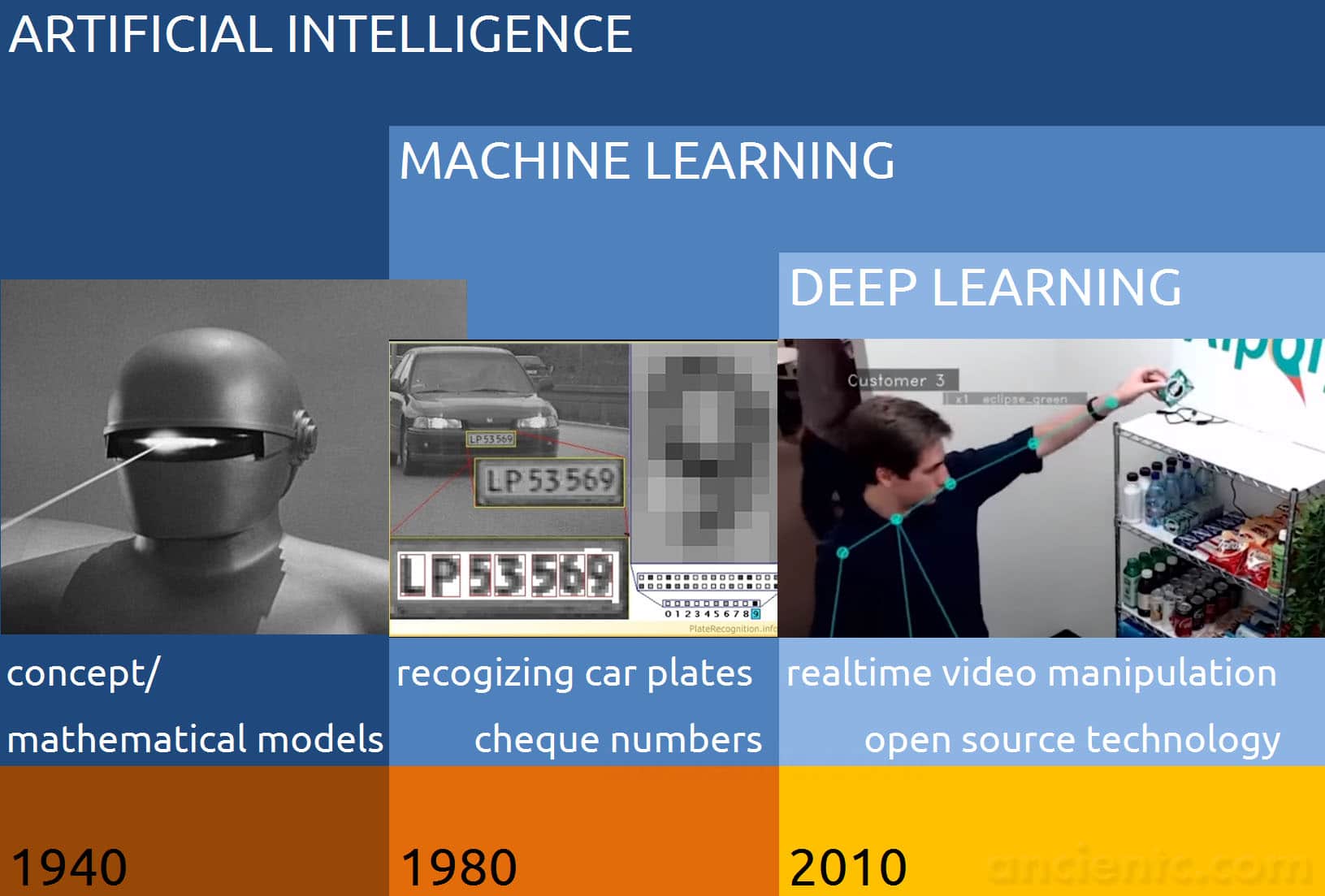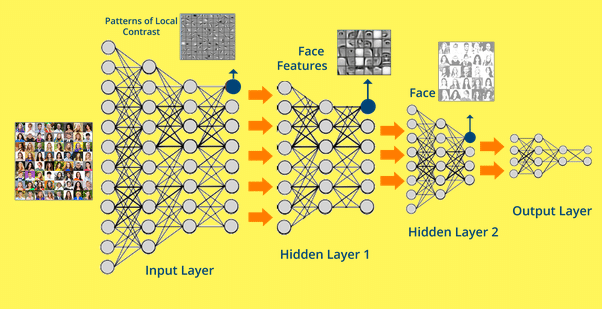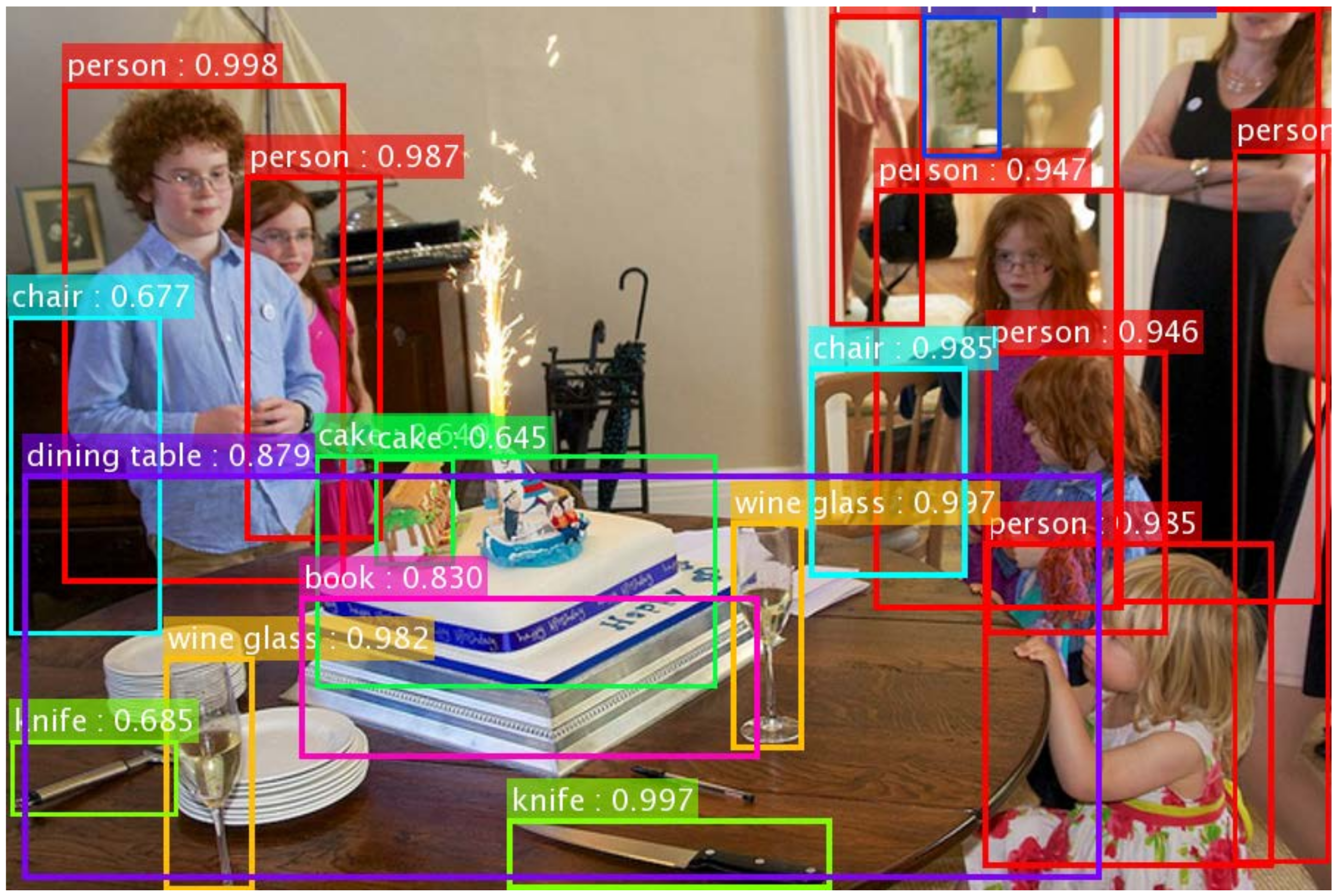We lose like half an hour each week staying in checkout lines. What if we could eliminate these waiting times? Moreover we waste up to 90% water by watering the ground between plants and not the plants themselves. What if we could give each plant the exact amount of water it needs? (Not to mention fertilizers and pesticides.) Soon we will be able to do these and much more using machine learning / deep learning solutions.
This small Italian company – Aipoly – is already able to recognize customer behaviour. But first let’s check some basics and see how this field evolves in 2018.

Starting 1940
To understand deep learning it is practical to start with artificial intelligence(AI).
Wikipedia defines AI like this: Artificial intelligence (AI) is intelligence demonstrated by machines, in contrast to the natural intelligence displayed by humans and other animals. (link) AI is quite a broad expression, first used by science fiction writers starting the 1300s (Ramon Llull). The concept became hot again in 1950s for example in Asimov’s Robot series. Still, at this stage this whole field was in the conceptual world.
From 1970-1980
Starting with the seventies machine learning left the unattainable concept of „self awareness” and focused on automatic learning systems: these system learned new behaviour based on data only without much manual intervention. Applications however usually combined machine learning and programmed computer logic to realize functions, like financial cheque scanning or car plate scanning. These very specific and limited applications functioned well, but other more general applications, like optical character recognition (OCR) suffered under varying recognition rates and thus often needed manual corrections.
From 2010
The current AI boom started in the earliy 2010, where at least factors helped the process:
- It was found out how to use graphical processors to train neural networks
- Graphical card processing power became sufficiently advanced and cheap, so you didn’t need a supercomputer to train your machine learning models (actually these graphic cards became cheap “supercomputers”)
What is deep learning anyway?
„When you hear the term deep learning, just think of a large deep neural net. Deep refers to the number of layers typically and so this kind of the popular term that’s been adopted in the press. I think of them as deep neural networks generally.” Jeff Dean

„The hierarchy of concepts allows the computer to learn complicated concepts by building them out of simpler ones. If we draw a graph showing how these concepts are built on top of each other, the graph is deep, with many layers. For this reason, we call this approach to AI deep learning.” Yoshua Bengio, Ian Goodfellow and Aaron Courville
Challenges in Deep Learning
Lack of skilled engineers
There are so many new possible applications so that we would need practically more than then thousand deep learning specialists. It will take time until enough developers and researchers will be trained.
Change anything change everything
A deep learning model has tens, maybe hundreds of parameters. Because of the training method if you change any parameter, the whole model has to be recalculated and redeployed. For example, if your animal recognition model doesn’t work for zebras, you have to retrain the whole neural network, what can mean days or weeks of work. Even if you can improve the model for zebras, you have to test again all animals you want to recognize.
Image Processing Focus
Deep learning brought a break-through in image processing. In other fields there are achievements, but they are not as spectacular. Natural Language Processing, voice recognition and any non visual data are still a hard nut to crack.
There are only probabilities, no 100% certainty
Deep learning models give you probabilities for certain categories. Then human engineers have to decide, what to accept and reject, how to evaluate the resutls. Therefore there will always be a chance of errror. These errors will be mostly human errors, the models are quite stable. Except:
False Positives

Technology Review AI False Positive
This is a so called “edge case”, a situation where a self driving car might behave unpredictably because of the false picture it perceives. AI-s thus must be trained to detect false positives and handle these cases. Moreover, self driving cars should have an array of sensors to reach safer than human driving.
Dark Side of Deep Learning
Privacy concerns
Neural networks can identify you as soon as your head gets 30-40m near from a good camera. (Even from the way you walk from the distance with a certain probability.) They can start collecting data about you with or without your knowledge. Even if laws and regulations prohibit data collection this will not stop certain organizations and individuals doing it.
deep learning face recognition
Total automatic government control
Earlier you needed thousands of spies and informants to control a large population. Now neural networks makes it much easier to identify and track millions of individuals.
Illegal and Unfair Election Influence
The company „Cambridge Analytics” collected and analyzed millions of user records. Using this data they were able to serve politically targeted ads in the 2016 US election. Similar methods were used by the “brexit” vote.
/cdn.vox-cdn.com/uploads/chorus_image/image/57135749/607814904.0.jpg)
Future of Deep Learning
Machine Learning as a Service
Human brain is functioning and learning at the same time. Fortune 100 companies like Google or Facebook – with thousands of qualified engineers – are able to mimic this ability: neural models will be continuously tested and deployed, thus improving recognition rates and eliminating some hurdles. They are offering this to smaller companies like „machine learning as a service”, MLaaS.

Cameras and Camcorders
I expect that mainstream cameras and camcorders will have machine learning included: improved automatic shutter settings, automatic tagging, multifocal recoding and automatic image creation later,…

Consumer identification
If you agree – hopefully –, you can be recognized as soon as you enter the premises. You will be served custom, interactive navigation information, advertisement and offers. You will be checked out automatically. Hand gestures will play a great role here.

Movie production
Human body can be now be digitized in 3D in five minutes for like fifty dollars. Textures and rigging is automatically applied. Production costs will decrease, movie production will be affordable for wider audiences. (Dark side: anyone can make a movie with Tom Hanks, Jennifer Lawrence, Michael Fassbender or with you.)
3D Interactive Development Environments like Unity 3D will play an important role here, as realtime rendering will be realistic for big projects.
http://www.sciencemag.org/news/2018/04/watch-artificial-intelligence-create-3d-model-person-just-few-seconds-video
Other Uses
Helping people to learn
Based on understanding how our brain and mind works we can develop programs to improve language learning.
- Measure progress of language learners (done successfuly by multiple companies)
- Use global and individual statistics (probabilities) for words/learning objects to create learning experiences
- Compare progress of different methods
- Fine tune and involve more and more learners
Game Design
Artificial enemies can now be adaptive, learning new tactics and strategies each minute the game is played.
https://www.assetstore.unity3d.com/en/#!/content/14379
Deep Learning Conclusions
- neural networks became relatively easy to create, train and test even with minimal mathematical background
- There are some mind blowing applications and each month you will see new ones coming
- Robots will be able to be trained easier and cheaper in the future
Acknowledgement
I had a great Deep Learning workshop with Rafael „Devil” Ordog at 14.Nov 2017. We got introduced to practical technologies like Keras, Tensor Flow, Jupyter notebooks and so on. We had the chance to even build our own neural networks and test them against some challenges.
References
The most practice oriented machine learning / deep learning course:
http://course.fast.ai/
A good overview of deep learning
What is Deep Learning?
https://machinelearningmastery.com/what-is-deep-learning/
About Machine Learning Challenges:
Machine Learning, Technical Debt, and You – D. Sculley (Google)
https://www.youtube.com/watch?v=V18AsBIHlWs
Papers from this talk:
Hidden Technical Debt in Machine Learning Systems
https://papers.nips.cc/paper/5656-hidden-technical-debt-in-machine-learning-systems.pdf
What is your ML Test Score?
https://static.googleusercontent.com/media/research.google.com/en//pubs/archive/46555.pdf
Some wild and interesting speculation about machine learning/artificial intelligence:
The AI Revolution: The Road to Superintelligence
https://waitbutwhy.com/2015/01/artificial-intelligence-revolution-1.html
3D model of anyone’s face and make it look like they are saying any sentence
https://twitter.com/i/web/status/984140066237726720
About the author
Zsolt Balai, author of this article, is a software developer since 1992. He is interested in UX, advanced AR/VR applications and cutting edge technology like deep learning.

Trackbacks/Pingbacks